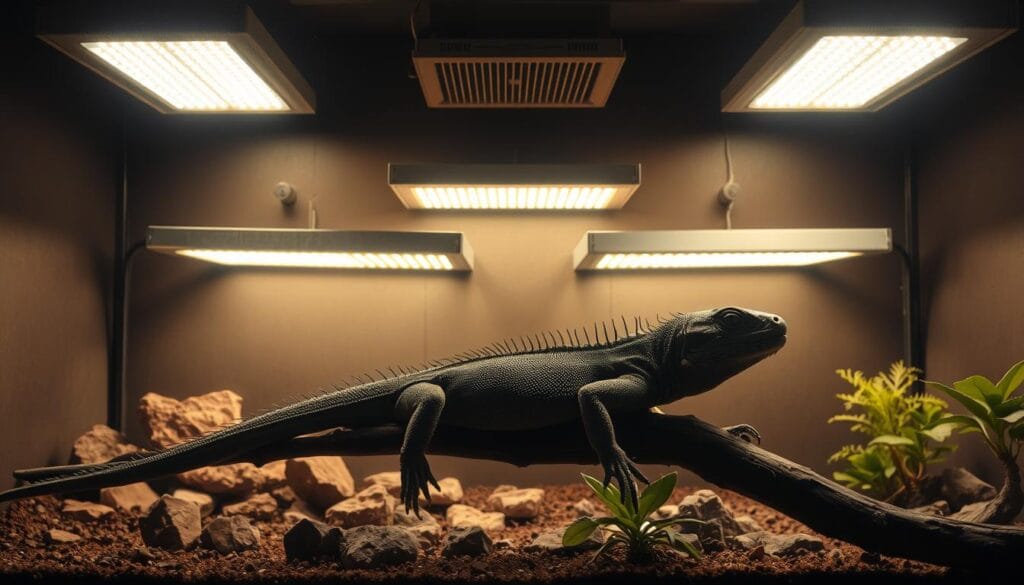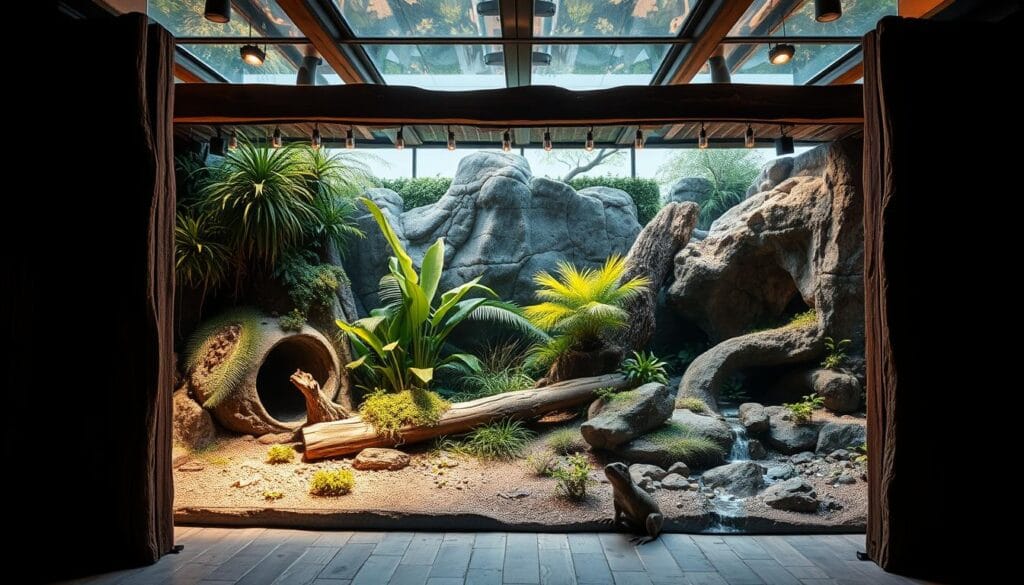Creating the perfect monitor lizard enclosure needs careful planning. It’s important to understand these amazing reptiles’ unique needs. You want a habitat that keeps your lizard safe and mimics their natural home.
Monitor lizards are complex creatures that need special spaces. Your enclosure ideas should focus on safety and comfort. Exotic pet experts suggest a habitat that meets their specific needs.
It’s key to know what monitor lizards need for a great home. Their habitats should have enough room for movement. They also need the right temperature, humidity, and chances to climb and explore.
Table of Contents
Understanding the Needs of Monitor Lizards
Monitor lizards are fascinating reptiles with unique needs. They require careful attention to their habitat and environment. This makes them challenging yet rewarding pets.
Creating a good home for monitor lizards is more than just a place to live. They are ectothermic, meaning they need external heat to stay warm. Proper heating is key for their health and how they function.
Essential Habitat Requirements
When setting up a monitor lizard habitat, keep these points in mind:
- Spacious enclosure with both horizontal and vertical space
- Natural substrate mimicking native environments
- Multiple hiding spots and climbing areas
- Robust ventilation system
Temperature and Humidity Dynamics
Keeping the environment just right is crucial for a monitor lizard’s health. They need a thermal gradient to control their body temperature.
| Habitat Zone | Temperature Range | Humidity Level |
|---|---|---|
| Basking Area | 86-90°F | 50-60% |
| Cool Zone | 75-80°F | 40-50% |
Your monitor lizard’s health depends on the right heat. Insufficient heating can lead to reduced appetite, compromised immune function, and potential long-term health issues. Use reliable heat lamps and check the temperature often with professional thermometers.
Choosing the Right Size for Your Enclosure
Finding the perfect enclosure for your monitor lizard is key for its health and happiness. Large reptile habitats need careful planning. This ensures your scaly friend has enough space to thrive. The enclosure size depends on several factors, like the species and size of your monitor lizard.
Monitor lizards come in all sizes, from small ones under a foot long to huge ones over six feet. Your enclosure ideas must consider this big size range.
Minimum Space Guidelines
Here are the essential guidelines for enclosure dimensions:
- Small monitor lizards (under 18 inches): Minimum 55-gallon tank
- Medium-sized monitors: Custom enclosure at least 6-8 feet long
- Large monitors: Custom-built habitat exceeding 8 feet in length
Vertical Space Considerations
Monitor lizards love to climb and need lots of vertical space. Vertical dimension is just as important as floor space. Your enclosure should let your lizard climb, explore, and show natural behaviors.
Experts say your enclosure should be at least 1.5 times the length and depth of your reptile. Younger monitors might feel too big in too much space. So, adjust as they grow.
Remember: Bigger enclosures are always better for curious and active reptiles!
Essential Materials for Building an Enclosure
Creating the perfect monitor lizard terrarium setup requires careful selection of materials and accessories. Your lizard’s comfort and safety depend on choosing the right components for their enclosure.
Recommended Building Materials
When designing monitor lizard enclosure ideas, you’ll want to consider several material options:
- Wood: Durable and insulating, but requires waterproof treatment
- PVC: Lightweight, easy to clean, and resistant to moisture
- Glass: Provides excellent visibility but can be heavy and challenging to maintain
| Material | Pros | Cons |
|---|---|---|
| Wood | Good insulation | Requires waterproofing |
| PVC | Easy to clean | Less natural appearance |
| Glass | Great visibility | Poor heat retention |
Accessories and Furnishings
A well-designed lizard terrarium setup goes beyond basic materials. Essential accessories include:
- Sturdy branches for climbing
- Rocks and hiding spots
- Substrate for comfort
- Secure locking mechanisms
Select materials that are non-toxic, easy to clean, and provide a stimulating environment for your monitor lizard. Prioritize safety and comfort in your enclosure design.
Ensuring Proper Ventilation and Lighting

Creating the perfect home for your monitor lizard needs focus on lighting and air flow. These are key for your reptile’s health and happiness.
Understanding Monitor Lizard Lighting Needs
Lighting is vital for your lizard’s day-night cycle. UVB lights help with vitamin D3 and calcium, keeping your lizard healthy.
- Use full-spectrum UVB bulbs made for reptiles
- Keep lights on for 12 hours, then off for 12 hours
- Place lights to match day and night cycles
Ventilation Strategies for Optimal Reptile Health
Good air flow stops breathing problems and keeps humidity right. Heating your lizard’s home is about finding the right balance.
- Put in mesh panels for air to move
- Adjust vents to control air flow
- Check humidity with a hygrometer
Good air flow helps control temperature and keeps air fresh. Make sure your lizard gets fresh air without feeling cold.
Pro tip: Create a gentle airflow that mimics natural wind patterns without causing temperature fluctuations.
Designing a Naturalistic Environment
Creating a monitor lizard substrate that looks like their natural home is key for their health and happiness. Naturalistic reptile enclosures are more than just places to live. They offer a complex space that meets your lizard’s physical and mental needs.
When setting up your monitor lizard’s home, remember these important points for a great space:
Substrate Selection for Optimal Comfort
Picking the right substrate is very important. Natural materials have many benefits:
- Cork granules are perfect for burrowing
- Soil and sand mixtures look like their native land
- Organic substrates help them act naturally
Creating Dynamic Climbing and Hiding Spaces
Naturalistic reptile enclosures need different features:
- Cork bark branches for climbing
- Grapewood vines for vertical fun
- Strategically placed rocks for basking
*”A well-designed habitat is more than an enclosure – it’s a miniature ecosystem”*
By choosing materials like cork and natural wood, you’ll make a space that’s not only beautiful. It also supports your monitor lizard’s natural behaviors and health.
Safety Features to Include in Your Enclosure
Creating a safe monitor lizard enclosure needs careful planning. It’s important to prevent escapes and keep your reptile safe. With the right ideas, you can make a secure and enriching space for your pet.
Secure Locking Mechanisms
A strong locking system is key for a safe outdoor lizard cage. Monitor lizards are smart and strong, so stopping them from escaping is vital. Here are some important locking strategies:
- Install heavy-duty, metal-based locks with multiple locking points
- Use padlock-compatible latches that resist reptile manipulation
- Choose locks with child-safety features for added security
- Implement sliding bolt mechanisms with additional safety clips
Escape Prevention Strategies
There are many ways to prevent escapes in your monitor lizard enclosure:
- Seal all potential gaps larger than 1/4 inch
- Use reinforced mesh or welded wire with small openings
- Create smooth interior walls without climbing opportunities
- Implement raised floor designs to prevent digging
Prevention is better than recovery with large, mobile reptiles. Regular checks and upkeep of your enclosure’s structure will keep your monitor lizard safe.
Maintenance Tips for Your Monitor Lizard Enclosure
Keeping your monitor lizard’s home clean is key to their health. It’s not just about looks; it’s about creating a safe, clean space for them to thrive.
To keep your lizard’s home right, you need a plan for cleaning and managing the environment.
Essential Cleaning Procedures
Regular cleaning stops health problems and keeps your lizard happy. Here’s a detailed cleaning schedule:
- Daily spot cleaning to remove waste and uneaten food
- Weekly deep cleaning of surfaces and accessories
- Monthly thorough disinfection of the entire enclosure
Temperature and Humidity Monitoring
Controlling the environment is crucial for your lizard’s survival. Use these tools to keep conditions perfect:
| Monitoring Tool | Purpose | Recommended Frequency |
|---|---|---|
| Digital Thermometer | Track ambient temperature | Multiple times daily |
| Hygrometer | Measure humidity levels | Daily |
| Infrared Thermometer | Check basking spot temperature | Weekly |
Nile monitors need daytime temps between 80°F to 90°F and nighttime temps around 78°F to 80°F. Always wash your hands before and after cleaning to avoid salmonella.
DIY vs. Pre-Made Enclosures: What’s Best?

Deciding on a habitat for your monitor lizard is a big choice. You must consider DIY and pre-made enclosures. This choice affects your reptile’s comfort and success.
When making a monitor lizard enclosure, think about your reptile’s needs and your skills. Both DIY and pre-made options have benefits that can greatly impact your pet’s life.
Advantages of DIY Construction
Building your own enclosure gives you total control. DIY fans get several benefits:
- Complete customization of dimensions and features
- Cost-effective solutions tailored to your budget
- Ability to design specific environmental zones
- Control over material selection and quality
Benefits of Buying Pre-Made Options
Pre-made enclosures are quick and reliable. They are perfect for those who want a hassle-free solution:
- Guaranteed structural integrity
- Professional design and engineering
- Consistent quality and safety standards
- Immediate usability without complex construction
| Feature | DIY Enclosure | Pre-Made Enclosure |
|---|---|---|
| Customization | High | Limited |
| Cost | Lower | Higher |
| Time Investment | Significant | Minimal |
| Professional Quality | Depends on Skills | Guaranteed |
Your choice depends on your skills, time, and your reptile’s needs. Think about what you can do and what your reptile needs. This will help you make the best choice for your situation.
Common Mistakes to Avoid When Setting Up
Setting up the perfect home for arboreal lizards needs careful planning. Many people make mistakes that can harm their lizards’ health. Knowing these mistakes is key to keeping your monitor lizard happy and healthy.
One big mistake is overcrowding. Monitor lizards need lots of space to live well. Too little room can cause stress, weaken their immune system, and lead to fights.
Keeping the right temperature and humidity is also crucial. Since they can’t control their own body heat, they rely on their environment. If it’s too cold or too dry, they might not eat well, feel tired, and get sick more easily. You need to make sure their home has the right temperature and humidity levels.
To check these conditions, you’ll need good thermometers and hygrometers. Choose the right heat lamp for your lizard and its home. Check your heating gear often and use timers to keep everything steady. This helps your lizard stay healthy and full of energy.

